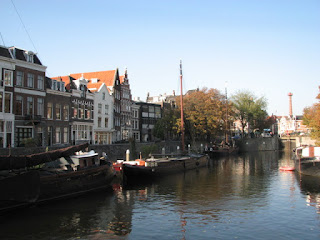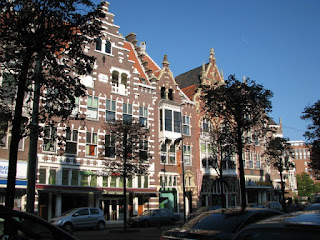Monday, October 24, 2011
We left Brussels early in the morning for Joe to make it back to work in Eindhoven. I took the train from Eindhoven to Rotterdam.
Rotterdam is considered the Netherlands New York, home to some of the world’s adventurist, futuristic architecture. The Germans had bombed the city to smithereens in 1940.
Centraal Station is currently under construction, but the renderings and the structural shell illustrate great bones for a new first impression of Rotterdam. Next it is was an interesting office building by architect Abe Bonnema. I took the metro to Blaak Rail Station. I realized later that I saw Het Boekenblok (‘Bookblock’) office building by KCAP behind it.
Piet Blom's Overblaak 70 development, aka Cube Houses was built in 1978-84. Piet Blom considers a single unit as an abstract tree and the lot as a forest. There are 36 apartments, 2 larger cubes, and 14 smaller spaces in use as a shop, studio or office built on a pedestrian bridge crossing the Blaak.The geometric chaos makes this architectural wonder a must-see in Rotterdam.
Kijk-Kubu (Look Cube) shows how one can live in an oddly shaped house like this. It contains custom designed and built furniture. A cube house has 3 floors in a cube and a storage place and entrance hall in the pole underneath. The unit is 100m². Whoever lives in this cube is still really stuck in the 70s.
White Huis built in 1847 is a regal 12 story building which is a rare survivor of the WWII bombing.
Willemsbrug is a 1981 signature bridge with red pylons.
De Hef railroad lifting drawbridge is now a national monument since its existence is superfluous now that the railway tunnel runs underneath the Maas River.
This hovering glass bar building is the new head office for Unilever Food by JHK Architecten above an old 1891 building.
Willemswerf built in 1998 is an office headquarters building of huge shipping company by architect W.G. Quist. The dramatic lines cast shadows on slick, white surfaces.
De Maastoren by Dam & Partners, at 165 meters, is currently the highest building in Rotterdam and the highest office building in The Netherlands. I really like how the color of the panels transition in the middle making a dark base and light top. There is a scary spider canopy climbing the base of the building.
The start of a floating quarter in the Rijnhaven by architects Public Domain Architecten.
This is the base of the New Orleans Tower by Portugese architect Alvaro Silva. At a height of 158 meters, this is the highest apartment building in the country.
The new Luxor Theatre by Australian architect Peter Wilson was completed in 2001. The façade has a prominent red rounded corner. I really like the entrance square directing visitors inside.
KPN Building is an office building built in 2000 by Renzo Piano. The building leans at a sharp angle and rests on long pole. The angle is the same 6 degrees as the Erasmusbridge pylons. The billboard façade glitters with 1000 odd green lamps flashing on and off creating images provided by the city, KPN Telecom and an art academy.
Erasmusbridge built in 1996 by architect Ben van Berkel, connecting the Southern suburbs with the city center.
The Red Apple is an apartment building built in 2009 by KCAP architects and designer Jan des Bouvries, K. Christiaanse. It has quickly become a new landmark for Rotterdam. I loved how the building façade changed as I moved to different angles around the city.
I ate at Dewi Sri for lunch which has some of the best Indonesian in Rotterdam.
Het Park is a maze of paths weaving between small lakes and ponds.
Euromast, rising 185m high, by architect H. A. Masskant towers above Het Park. The glass-walled ‘Euroscope’ contraption rotates for unparalleled 360 degree views of Rotterdam. I chose not to go up since a large boy scout troop was waiting in line outside the entrance and I only had a few more hours left in the city.
Kunsthal Museum, designed by Rem Koolhaas. The lack of elevator with only a central ramp with a crazy ski slope for those in wheelchairs could never be built in America. If it could, then Rem Koolhaas’ Seattle’s Central Library would have had worse circulation issues than it already does.
Museum Park, designed in collaboration by Rem Koolhaas and Frenchman Yves Brunier is home to 5 museums and outdoor sculptured terraces.
Netherlands Architecture Institute (NAI) by Jo Coenen. One side is surrounded by a moat.
I took the metro to Delfshaven to see some of the few remaining historic sights in Rotterdam.
I got a little lost walking from the metro station since my map was missing many street names in this area. Fortunately I was on the right path when I finally spotted Delfshaven windmill. De Distilleerketel (the Distillers’ Kettle) was rebuilt in 1986 after the original mill was destroyed in WWII. The mill is apparently still active (not at time for viewing) providing grinding wheat for much of the city.
Historic Delfshaven is charming 17th-century area along 2 canals.
Delfshaven’s claim to fame is the Pilgrims prayed here at Oudekerk before departing in 1620 on Speedwell to eventually taking the Mayflower to Plymouth.
After this I took the train back to Eindhoven. Joe and I went out for dim sum for dinner. Eindhoven seems to have a good number of Asians with such a large amount of technology industries located here. We went to bed early since I had to take an early train to Amsterdam Schiphol Airport.
I think Chance had a good time with the other dogs at Bone-A-Fide Dog Ranch while I was gone. She was one dirty pup.













































































































No comments:
Post a Comment